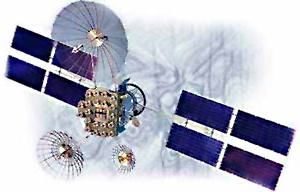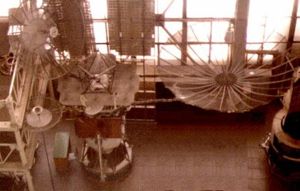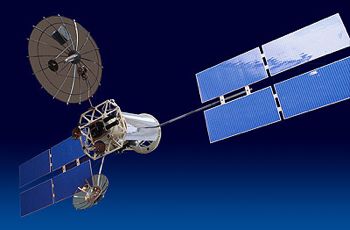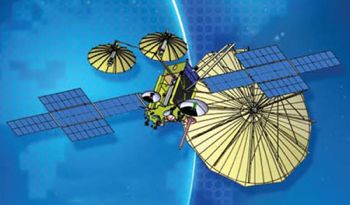
Home - Search - Browse - Alphabetic Index: 0- 1- 2- 3- 4- 5- 6- 7- 8- 9
A- B- C- D- E- F- G- H- I- J- K- L- M- N- O- P- Q- R- S- T- U- V- W- X- Y- Z
Luch
 Luch Credit: NPO PM |
AKA: 11F669;Altair. Status: Operational 1985. First Launch: 1985-10-25. Last Launch: 1995-10-11. Number: 5 . Gross mass: 2,170 kg (4,780 lb).
Luch was an element of the second generation global command and control system (GKKRS) developed according to a decree of 17 February 1976 and deployed in the first half of the 1980's. Luch satellites, analogous to the US TDRS, provided communications service to the Mir space station, Buran space shuttle, Soyuz-TM spacecraft, military satellites, and the TsUPK ground control center. They also served to provide mobile fleet communications for the Soviet Navy. Modifications of the basic design were known as Altair, Gelios, and Luch. The modernized Luch-2 model allowed two high data rate channels to operate simultaneously, permitting transmission of real-time television from Mir. Each satellite was equipped with three transponders and had a nominal life of five years. By January 1999 five had been launched.
Luch utilized the KAUR-4 spacecraft bus equipped with the Arion transponder by NPO Radiopribor (Ryazanskiy). The spacecraft had an active 3-axis orientation system, with a single central body from which extended 40 square meters of solar panels. Its basic structure was that of the KAUR-3, but it was equipped with completely new systems: a digital computer, plasma station-keeping engines, hydrazine monopropellant orientation engines, and actively-scanned antennae arrays with 0.5 degrees antenna and 0.1 degree spacecraft pointing accuracy.
The Satellite Data Relay Network (SDRN) was analogous to the U.S. Tracking and Relay Satellite System (TDRSS). Three Luch spacecraft (not to be confused with the transponder system on Gorizont spacecraft) were launched between 1985 and 1989: Cosmos 1700, Cosmos 1897, and Cosmos 2054. Although three locations were registered with the International Telecommunications Union (16 degrees W, 95 degrees E, and 160 degrees W), only the first two were employed.
Each Luch spacecraft (also referred to Altair satellites) had a mass of 2.4 metric tons and two extended solar arrays capable of supplying 1.8 kW. Three large antennas and numerous, small helical antennas permitted data relays in the 15/14, 15/11, and 0.9/0.7 GHz bands. Terrestrial stations could employ simple 0.8-2 m antennas. The Luch spacecraft had a design lifetime of 5 years.
At the beginning of 1993 the only operational Luch spacecraft was Cosmos 2054, stationed at 16 degrees W. On 16 December 1994 Luch 1 was launched and later positioned at 95 E. This 2-satellite network was then used primarily in support of the Mir space station program.
More at: Luch.
Family: Communications, Geosynchronous orbit, Military communications sat. Country: Russia. Engines: SPT-70. Launch Vehicles: Proton, Proton-K/DM-2. Launch Sites: Baikonur, Baikonur LC81/23, Baikonur LC200/40, Baikonur LC200/39. Agency: MOM, Reshetnev bureau. Bibliography: 102, 2, 274, 445, 450, 474, 6, 67, 6659, 12768, 12769.
 | Comsat MAI, March 1994 Credit: © Dietrich Haeseler |
 | Luch Credit: USAF Phillips Laboratory |
 | Luch Credit: Manufacturer Image |
 | Luch 1 Credit: Manufacturer Image |
 | Yenisey A1 Credit: Manufacturer Image |
 | Cosmos 2054 Credit: Manufacturer Image |
1976 February 17 - .
- Energia; Buran; Mir; Luch; Potok approved; N1 formally cancelled. - .
Nation: Russia.
Spacecraft: Buran,
Gamma,
Luch,
Mir,
Mir-2,
Potok.
Central Committee of the Communist Party and Council of Soviet Ministers Decree 'On work on Energia-Buran, DOS-7K nos. 7 and 8, Gamma. Geyzer (Potok), and Altair (Luch) and cancellation of the N1' was issued. The design of an improved model of the Salyut DOS-17K space station was authorised as part of the third generation of Soviet space systems in a decree. At that time it was planned that the two stations (DOS-7 and DOS-8) would be equipped with two docking ports at either end of the station and an additional two ports at the sides of the forward small diameter compartment. Luch and Potok were elements of the second generation global command and control system (GKKRS) deployed in the first half of the 1980's. Luch satellites, analogous to the US TDRS, provided communications service to the Mir space station, Buran space shuttle, Soyuz-TM spacecraft, military satellites, and the TsUPK ground control center. They also served to provide mobile fleet communications for the Soviet Navy. Additional Details: here....
1985 October 25 - . 15:45 GMT - . Launch Site: Baikonur. Launch Complex: Baikonur LC200/40. LV Family: Proton. Launch Vehicle: Proton-K/DM-2.
- Cosmos 1700 - .
Payload: Luch s/n 11L. Mass: 2,000 kg (4,400 lb). Nation: Russia.
Agency: MOM.
Class: Communications.
Type: Military communications satellite. Spacecraft Bus: KAUR-4.
Spacecraft: Luch .
Completed Operations Date: 1986-09-01 . USAF Sat Cat: 16199 . COSPAR: 1985-102A. Apogee: 35,794 km (22,241 mi). Perigee: 35,777 km (22,230 mi). Inclination: 5.90 deg. Period: 1,436.10 min.
Stationed at 95 deg E. Experimental retransmission of telephone and telegraph data in the centimetre band. First launch in Altair/SR system for communication with Mir space station and other orbital spacecraft. First tests with Mir were conducted on 29 March 1986 using Mir's large aft antenna communicating with Cosmos 1700 stationed in geosynchronous orbit at 95 degrees East. In September 1986 Cosmos 1700 ceased operating and drifted off its geosynchronous orbit position. Positioned in geosynchronous orbit at 95 deg E in 1985-1986 As of 4 September 2001 located at 85.03 deg E drifting at 0.142 deg W per day. As of 2007 Mar 10 located at 76.37E drifting at 0.157E degrees per day.
1987 November 26 - . 13:28 GMT - . Launch Site: Baikonur. Launch Complex: Baikonur LC200/39. LV Family: Proton. Launch Vehicle: Proton-K/DM-2.
- Cosmos 1897 - .
Payload: Luch s/n 12L. Mass: 2,000 kg (4,400 lb). Nation: Russia.
Agency: MOM.
Class: Communications.
Type: Military communications satellite. Spacecraft Bus: KAUR-4.
Spacecraft: Luch .
Completed Operations Date: 1992-10-01 . USAF Sat Cat: 18575 . COSPAR: 1987-096A. Apogee: 35,790 km (22,230 mi). Perigee: 35,763 km (22,222 mi). Inclination: 3.80 deg. Period: 1,435.60 min.
Stationed at 95 deg E. Relaying of telephone and telegraph information. Second launch in Altair/SR system for communication with Mir space station and other orbital spacecraft. In late July 1988 Cosmos 1897 was moved from its station at 95 degrees East to 12 degrees East to support the Buran shuttle test flight of November 14, 1988. During February 1987 the satellite was moved back to its original position at 95 degrees East. The satellite drifted to 90 degrees East by March 1991. By late April it was maneuvered it back to 95 degrees East, but by the end of 1991 it had drifted to 77 degrees East and was considered inoperative. Positioned in geosynchronous orbit at 95 deg E in 1987-1988; 12 deg E in 1988-1989; 95 deg E in 1989-1992 As of 5 September 2001 located at 62.12 deg E drifting at 0.168 deg W per day. As of 2007 Mar 10 located at 94.48E drifting at 0.087E degrees per day.
1989 December 27 - . 11:10 GMT - . Launch Site: Baikonur. Launch Complex: Baikonur LC200/39. LV Family: Proton. Launch Vehicle: Proton-K/DM-2.
- Cosmos 2054 - .
Payload: Luch s/n 14L. Mass: 2,150 kg (4,730 lb). Nation: Russia.
Agency: MOM.
Class: Communications.
Type: Military communications satellite. Spacecraft Bus: KAUR-4.
Spacecraft: Luch .
Completed Operations Date: 1997-03-01 . USAF Sat Cat: 20391 . COSPAR: 1989-101A. Apogee: 35,822 km (22,258 mi). Perigee: 35,777 km (22,230 mi). Inclination: 7.70 deg. Period: 1,436.80 min.
Stationed at 346 deg E. Relaying of telegraph and telephone information. The third Altair/SR geosynchronous satellite for communication with Mir space station and other orbital spacecraft. Combined with Cosmos 1897, it permitted Mir to maintain contact with Mission Control in Moscow 70% of the time. Positioned in geosynchronous orbit at 16 deg W in 1990-1997 As of 30 August 2001 located at 21.03 deg W drifting at 0.023 deg E per day. As of 2007 Mar 9 located at 68.57W drifting at 0.338W degrees per day.
1994 December 16 - . 12:00 GMT - . Launch Site: Baikonur. Launch Complex: Baikonur LC81/23. LV Family: Proton. Launch Vehicle: Proton-K/DM-2.
- Luch - .
Payload: Luch s/n 13L. Mass: 2,300 kg (5,000 lb). Nation: Russia.
Agency: MOM.
Class: Communications.
Type: Military communications satellite. Spacecraft Bus: KAUR-4.
Spacecraft: Luch .
Completed Operations Date: 1998-08-01 . USAF Sat Cat: 23426 . COSPAR: 1994-082A. Apogee: 35,815 km (22,254 mi). Perigee: 35,757 km (22,218 mi). Inclination: 2.48 deg. Period: 1,436.09 min.
Stationed at 95 deg E. Relaying of telegraph and telephone information. Improved Altair/SR geosynchronous satellite for communication with Mir space station and other orbital spacecraft. Positioned in geosynchronous orbit at 95 deg E in 1994-1997; 16 deg W in 1997-1998 As of 4 September 2001 located at 143.35 deg W drifting at 0.319 deg E per day. As of 2007 Mar 9 located at 64.95W drifting at 0.320E degrees per day.
1995 October 11 - . 16:26 GMT - . Launch Site: Baikonur. Launch Complex: Baikonur LC81/23. LV Family: Proton. Launch Vehicle: Proton-K/DM-2.
- Luch 1 - .
Payload: Luch. Mass: 2,400 kg (5,200 lb). Nation: Russia.
Agency: MOM.
Class: Communications.
Type: Military communications satellite. Spacecraft Bus: KAUR-4.
Spacecraft: Luch.
Completed Operations Date: 1999-06-01 . USAF Sat Cat: 23680 . COSPAR: 1995-054A. Apogee: 35,817 km (22,255 mi). Perigee: 35,754 km (22,216 mi). Inclination: 2.60 deg. Period: 1,436.00 min.
Stationed at 77 deg E. Relaying of telegraph and telephone information. Improved Altair/SR geosynchronous satellite for communication with Mir space station and other orbital spacecraft. Positioned in geosynchronous orbit at 77 deg E in 1995-1999 As of 2 September 2001 located at 75.63 deg E drifting at 0.029 deg W per day. As of 2007 Mar 10 located at 77.39E drifting at 0.002E degrees per day.
Back to top of page
Home - Search - Browse - Alphabetic Index: 0- 1- 2- 3- 4- 5- 6- 7- 8- 9
A- B- C- D- E- F- G- H- I- J- K- L- M- N- O- P- Q- R- S- T- U- V- W- X- Y- Z
© 1997-2019 Mark Wade - Contact
© / Conditions for Use